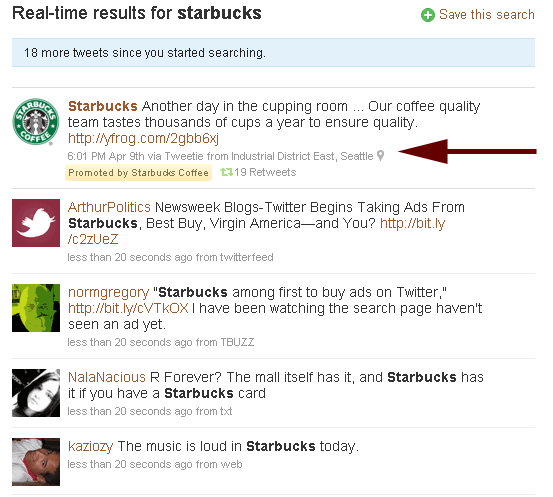
Yesterday, Twitter unveiled its new advertising platform Promoted Tweets. The picture above shows a Promoted Tweet from Starbucks when searching for the keyword “starbucks” on Twitter. I pulled information from The New York Times, Twitter’s blog, and Twitter COO Dick Costolo’s talk at Ad Age, and here are some details that have emerged about Promoted Tweets:
- Currently, one (rather than multiple) Promoted Tweet will show at the top of some Twitter search results. The tweet will be clearly marked as “Promoted by…” to identify itself as a sponsored tweet.
- Initially, Promoted Tweets will appear to only users who already follow the sponsoring company on Twitter. The above Promoted Tweet from Starbucks did not show up in my search stream until I started to follow Starbucks.
- To keep a Promoted Tweet in the stream, it needs to demonstrate “resonance” among users, via retweets and replies. Tweets that users have cold reaction to will be removed from the stream. At the time when I captured the screenshot above, at about 4PM yesterday, the Starbucks Promoted Tweet had been retweeted 19 times (shown with the tweet). At the time of writing, that number has increased to 54.
- Advertisers will initially bid on cost-per-thousand (CPM) as used in traditional advertising. But it will eventually move toward a resonance-based pricing.
- As Twitter refines the platform, Promoted Tweets may eventually show up in user streams (instead of just search results).
- The first group of advertisers that are participating in Promoted Tweets include Starbucks, Best Buy, Red Bull, Bravo, Sony Pictures, and Virgin America.
Now that Promoted Tweets are official, a key question for loyalty marketers is how it will impact loyalty practice. I think at least three pretty profound implications can be identified.
Loyal Customer Redefined
Traditionally, a loyal customer is considered someone who has been with a company for a while and who spends a significant amount of money at the company. But with Promoted Tweets and future social integrations, a company’s most valuable customers may have to possess an additional quality: brand passion, passionate enough to act as ambassadors for the brand. Because the appearance of a Promoted Tweet depends on consumer resonance levels, a large part of its impact is going to come from pass-alongs. Similar to how a higher quality score can lower the cost of search engine ads, resonance will eventually influence the cost of Twitter (and potentially other social media) campaigns. The more groundswell your customers can help you generate, the more effective your marketing dollars in this area are going to be.
Relatedly, although the Promoted Tweets platform is initially on a pay-per-view basis, with its focus on resonance, I believe it will eventually bring about a new groundswell-based ad pricing system. This will become accountability 3.0, going beyond the revolution from a pay-per-view structure with traditional media to a pay-per-click or pay-per-action system with search engines, and now onto a pay-per-groundswell future.
Relevance is King
Of course, having customers who are eager to spread your messages is only part of the equation. You have to provide relevant messages that customers consider worthy of passing along. My own research found that the top reason for passing along information is the relevance of the information to those you want to share it with, and that factor ranked above the humor element. Deep down, we want to be helpful, and we want to offer our friends value. By being relevant, companies can help us fulfill that innate social need. Earlier today, Starbucks had another Promoted Tweet that tells users to bring in a reusable tumbler to get a free cup of coffee. Compared with the one shown in the picture above, you can imagine this other message to be more relevant to a larger group of consumers, and not surprisingly got more reactions.

Source: Twitter Blog
Real-Time Cross-Channel Integration
Many of us have witnessed a surge of tweets and other social media updates during significant events and popular TV shows. In the future, traditional media consumption will be social and will be integrated with our online social media experience. Promoted Tweets provides an accessible way of doing that. Given that Twitter runs in real-time, companies using Promoted Tweets can easily syndicate customer conversations with their marketing messages in other media. The New York Times article discusses how this can be used with a movie release. In a broader context, a company can use this platform to solicit real-time reaction when its commercial is on, provide additional information, and turn one-way mass media into a two-way dialogue. The challenge of this, of course, is the speed of response and cross-platform integration. Many companies today have a separate team running their social media efforts, which may limit the synergy that can be created in a more integrated environment.
In the end, I think the most important aspect of Promoted Tweets is not going to be the specific technology. Rather, it lies in the paradigm/mentality shift that it will bring about in loyalty marketing.